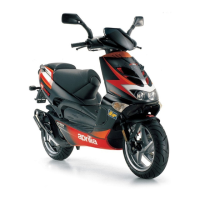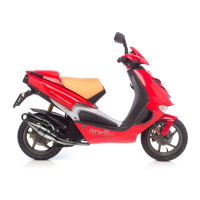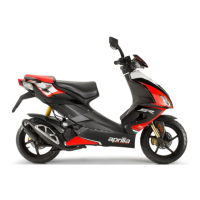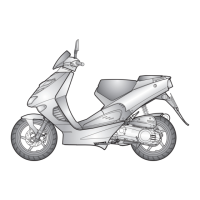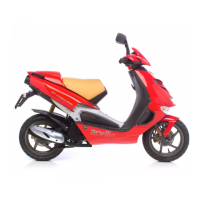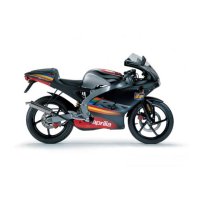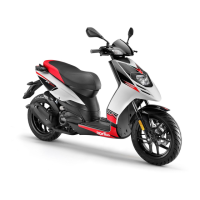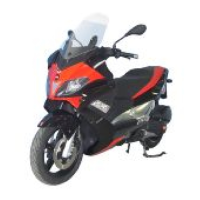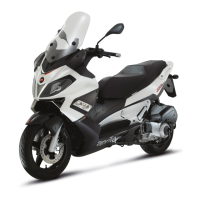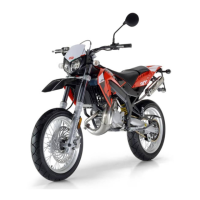Do you have a question about the APRILIA SR 50 - 2004 and is the answer not in the manual?
Symbol for personal injury risk; WARNING for serious injury/death; CAUTION for minor injury/damage.
Read manual, focus on safe riding, rider's condition impacts safety.
Observe rules, avoid risks, maintain correct posture, and be aware of surroundings.
Do not modify vehicle; report malfunctions; never race or ride off-road.
Details rev counter, fuel/temp indicators, warning lights, speedometer, odometer.
Explains meaning and function of warning lights, indicators, speedometer, etc.
Details speedometer, fuel/temp indicators, warning lights, odometer, digital clock.
Mixer oil low indicator and coolant temp indicator with associated warnings.
Warns of general failure, injection system problems, or other critical issues.
Use Mode button to select clock, ODO, TRIP, battery voltage, and trip meter reset.
Safety code needed to start vehicle; customize and store it securely.
Always select function with vehicle stopped.
Use for safety or emergency stop; do not operate while riding.
Operates ignition, steering lock, battery/tool kit, and seat locks.
Never turn key to lock position while riding to avoid losing control.
Fuel is flammable; refuel in ventilated area, away from ignition sources.
Handle oil with care, wear gloves, keep away from children, do not dispose of oil in environment.
Sudden changes in lever play may indicate hydraulic system problems.
Brakes ensure safety; check before every trip; clean discs/pads.
Check fluid level periodically; it decreases as pads wear.
Do not ride if fluid is low; contact dealer to top up after checking pads.
Check coolant level every 2000 km; change every 2 years. Do not ride below minimum.
Coolant is toxic; handle with care; use correct mixture and temperature adjustments.
Do not remove expansion tank plug when engine is hot due to pressure and heat.
Wait for engine to cool; check fluid level between MIN and MAX marks.
Periodically check pressure; incorrect pressure affects ride, grip, and safety.
Catalytic muffler reaches high temperature; avoid contact and park away from flammable materials.
Tampering with noise control system is prohibited by law; check system operation.
Perform pre-ride checks for safe riding; failure can lead to injury or damage.
Exhaust gases are toxic; do not start engine in enclosed or poorly ventilated areas.
Steps for electric starting including centre stand, ignition switch, and starter button usage.
Starter button usage rules and engine warm-up procedure after starting.
Steps to diagnose if engine doesn't start, including spark plug check.
Read "Safe Riding"; heed fuel reserve light; passengers allowed in certain countries.
Avoid repeated throttle use; warm up engine by riding slowly.
Use both brakes for smooth deceleration; avoid braking in turns.
Ride slowly on slippery surfaces; signal intentions; avoid sudden maneuvers.
General alarm, oil reserve, and coolant temperature warning lights.
Follow specific speed and throttle limits for the first 500 km for proper break-in.
Carry out checks after first 500 km to ensure safety and prevent damage.
Avoid abrupt stops; brake gradually; keep brake applied for brief stops.
Park on firm, level ground; prevent falling; ensure hot parts don't pose risk.
Avoid leaving ignition on; never leave key in ignition; always lock steering.
Ensure vehicle is stable after placing on stand or straightening.
Do not use brake lock devices; always use steering lock; park securely.
Stop engine, extract key, let cool; work in ventilated area; keep away from hot parts.
Operations to be carried out after the first 500 km (312 mi).
Record frame and engine numbers; frame number needed for spare parts.
Altering identification numbers is illegal and invalidates warranty.
Ensure vehicle is stable and properly supported before disassembly.
Ensure components are clean; do not contaminate with lubricants.
Symbol for personal injury risk; WARNING for serious injury/death; CAUTION for minor injury/damage.
Read manual, focus on safe riding, rider's condition impacts safety.
Observe rules, avoid risks, maintain correct posture, and be aware of surroundings.
Do not modify vehicle; report malfunctions; never race or ride off-road.
Details rev counter, fuel/temp indicators, warning lights, speedometer, odometer.
Explains meaning and function of warning lights, indicators, speedometer, etc.
Details speedometer, fuel/temp indicators, warning lights, odometer, digital clock.
Mixer oil low indicator and coolant temp indicator with associated warnings.
Warns of general failure, injection system problems, or other critical issues.
Use Mode button to select clock, ODO, TRIP, battery voltage, and trip meter reset.
Safety code needed to start vehicle; customize and store it securely.
Always select function with vehicle stopped.
Use for safety or emergency stop; do not operate while riding.
Operates ignition, steering lock, battery/tool kit, and seat locks.
Never turn key to lock position while riding to avoid losing control.
Fuel is flammable; refuel in ventilated area, away from ignition sources.
Handle oil with care, wear gloves, keep away from children, do not dispose of oil in environment.
Sudden changes in lever play may indicate hydraulic system problems.
Brakes ensure safety; check before every trip; clean discs/pads.
Check fluid level periodically; it decreases as pads wear.
Do not ride if fluid is low; contact dealer to top up after checking pads.
Check coolant level every 2000 km; change every 2 years. Do not ride below minimum.
Coolant is toxic; handle with care; use correct mixture and temperature adjustments.
Do not remove expansion tank plug when engine is hot due to pressure and heat.
Wait for engine to cool; check fluid level between MIN and MAX marks.
Periodically check pressure; incorrect pressure affects ride, grip, and safety.
Catalytic muffler reaches high temperature; avoid contact and park away from flammable materials.
Tampering with noise control system is prohibited by law; check system operation.
Perform pre-ride checks for safe riding; failure can lead to injury or damage.
Exhaust gases are toxic; do not start engine in enclosed or poorly ventilated areas.
Steps for electric starting including centre stand, ignition switch, and starter button usage.
Starter button usage rules and engine warm-up procedure after starting.
Steps to diagnose if engine doesn't start, including spark plug check.
Read "Safe Riding"; heed fuel reserve light; passengers allowed in certain countries.
Avoid repeated throttle use; warm up engine by riding slowly.
Use both brakes for smooth deceleration; avoid braking in turns.
Ride slowly on slippery surfaces; signal intentions; avoid sudden maneuvers.
General alarm, oil reserve, and coolant temperature warning lights.
Follow specific speed and throttle limits for the first 500 km for proper break-in.
Carry out checks after first 500 km to ensure safety and prevent damage.
Avoid abrupt stops; brake gradually; keep brake applied for brief stops.
Park on firm, level ground; prevent falling; ensure hot parts don't pose risk.
Avoid leaving ignition on; never leave key in ignition; always lock steering.
Ensure vehicle is stable after placing on stand or straightening.
Do not use brake lock devices; always use steering lock; park securely.
Stop engine, extract key, let cool; work in ventilated area; keep away from hot parts.
Operations to be carried out after the first 500 km (312 mi).
Record frame and engine numbers; frame number needed for spare parts.
Altering identification numbers is illegal and invalidates warranty.
Ensure vehicle is stable and properly supported before disassembly.
Ensure components are clean; do not contaminate with lubricants.
| Brand | APRILIA |
|---|---|
| Model | SR 50 - 2004 |
| Category | Motorcycle |
| Language | English |
